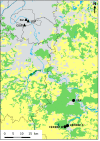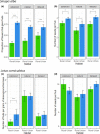Broader phenology of pollinator activity and higher plant reproductive success in an urban habitat compared to a rural one
- PMID: 33144987
- PMCID: PMC7593137
- DOI: 10.1002/ece3.6794
Broader phenology of pollinator activity and higher plant reproductive success in an urban habitat compared to a rural one
Abstract
Urban habitat characteristics create environmental filtering of pollinator communities. They also impact pollinating insect phenology through the presence of an urban heat island and the year-round availability of floral resources provided by ornamental plants.Here, we monitored the phenology and composition of pollinating insect communities visiting replicates of an experimental plant assemblage comprising two species, with contrasting floral traits: Sinapis alba and Lotus corniculatus, whose flowering periods were artificially extended. Plant assemblage replicates were set up over two consecutive years in two different habitats: rural and densely urbanized, within the same biogeographical region (Ile-de-France region, France).The phenology of pollination activity, recorded from the beginning (early March) to the end (early November) of the season, differed between these two habitats. Several pollinator morphogroups (small wild bees, bumblebees, honeybees) were significantly more active on our plant sets in the urban habitat compared to the rural one, especially in early spring and autumn. This resulted in different overall reproductive success of the plant assemblage between the two habitats. Over the course of the season, reproductive success of S. alba was always significantly higher in the urban habitat, while reproductive success of L. corniculatus was significantly higher in the urban habitat only during early flowering.These findings suggest different phenological adaptations to the urban habitat for different groups of pollinators. Overall, results indicate that the broadened activity period of pollinating insects recorded in the urban environment could enhance the pollination function and the reproductive success of plant communities in cities.
Keywords: Lotus corniculatus; Sinapis alba; flowering phenology manipulation; phenology; plant reproductive success; plant–pollinator interactions; pollinator assemblage composition; urban–rural gradient.
© 2020 The Authors. Ecology and Evolution published by John Wiley & Sons Ltd.
Conflict of interest statement
None declared.
Figures






Similar articles
-
Effects of ozone stress on flowering phenology, plant-pollinator interactions and plant reproductive success.Environ Pollut. 2021 Mar 1;272:115953. doi: 10.1016/j.envpol.2020.115953. Epub 2020 Oct 29. Environ Pollut. 2021. PMID: 33190978
-
Seasonal Variations of Pollinator Assemblages among Urban and Rural Habitats: A Comparative Approach Using a Standardized Plant Community.Insects. 2021 Feb 27;12(3):199. doi: 10.3390/insects12030199. Insects. 2021. PMID: 33673434 Free PMC article.
-
A "plan bee" for cities: Pollinator diversity and plant-pollinator interactions in urban green spaces.PLoS One. 2020 Jul 15;15(7):e0235492. doi: 10.1371/journal.pone.0235492. eCollection 2020. PLoS One. 2020. PMID: 32667935 Free PMC article.
-
Crop-pollinating Diptera have diverse diets and habitat needs in both larval and adult stages.Ecol Appl. 2023 Jul;33(5):e2859. doi: 10.1002/eap.2859. Epub 2023 May 24. Ecol Appl. 2023. PMID: 37092886 Review.
-
The effects of urbanization on pollinators and pollination: A meta-analysis.Ecol Lett. 2023 Sep;26(9):1629-1642. doi: 10.1111/ele.14277. Epub 2023 Jun 22. Ecol Lett. 2023. PMID: 37345567 Review.
Cited by
-
Who can pass the urban filter? A multi-taxon approach to disentangle pollinator trait-environmental relationships.Oecologia. 2022 May;199(1):165-179. doi: 10.1007/s00442-022-05174-z. Epub 2022 May 4. Oecologia. 2022. PMID: 35505250 Free PMC article.
-
Native and exotic plants play different roles in urban pollination networks across seasons.Oecologia. 2023 Feb;201(2):525-536. doi: 10.1007/s00442-023-05324-x. Epub 2023 Jan 24. Oecologia. 2023. PMID: 36692691 Free PMC article.
-
Gardens reduce seasonal hunger gaps for farmland pollinators.Proc Biol Sci. 2024 Oct;291(2033):20241523. doi: 10.1098/rspb.2024.1523. Epub 2024 Oct 23. Proc Biol Sci. 2024. PMID: 39437845 Free PMC article.
-
Urbanization extends flight phenology and leads to local adaptation of seasonal plasticity in Lepidoptera.Proc Natl Acad Sci U S A. 2021 Oct 5;118(40):e2106006118. doi: 10.1073/pnas.2106006118. Proc Natl Acad Sci U S A. 2021. PMID: 34580222 Free PMC article.
-
Keeping Up with Insect Pollinators in Paris.Animals (Basel). 2022 Apr 4;12(7):923. doi: 10.3390/ani12070923. Animals (Basel). 2022. PMID: 35405911 Free PMC article.
References
-
- Baldock, K.C.R. , Goddard, M.A. , Hicks, D.M. , Kunin, W.E. , Mitschunas, N. , Osgathorpe, L.M. , … Memmott, J. (2015). Where is the UK’s pollinator biodiversity? The importance of urban areas for flower‐visiting insects. Proceedings of the Royal Society B: Biological Sciences, 282, 20142849 10.1098/rspb.2014.2849 - DOI - PMC - PubMed
-
- Banaszak‐Cibicka, W. , Twerd, L. , Fliszkiewicz, M. , Giejdasz, K. , & Langowska, A. (2018). City parks vs. natural areas ‐ is it possible to preserve a natural level of bee richness and abundance in a city park? Urban Ecosystems, 21(4), 599–613. 10.1007/s11252-018-0756-8 - DOI
-
- Brooks, M.E. , Kristensen, K. , Benthem, K.J. , Magnusson, A. , Berg, C.W. , Nielsen, A. , … Bolker, B.M. (2017). glmmTMB balances speed and flexibility among packages for zero‐inflated generalized linear mixed modeling. R Journal, 9(2), 378–400. 10.32614/RJ-2017-066 - DOI
LinkOut - more resources
Full Text Sources
Miscellaneous

